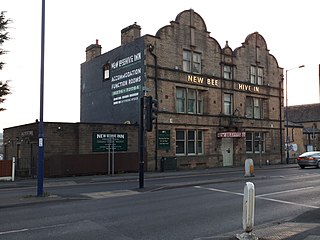
The Campaign for Real Ale (CAMRA) is an independent voluntary consumer organisation headquartered in St Albans, England, which promotes real ale, cider and perry and traditional British pubs and clubs. With just over 150,000 members, it is the largest single-issue consumer group in the UK, and is a founding member of the European Beer Consumers Union (EBCU).

A pub is a drinking establishment licensed to serve alcoholic drinks for consumption on the premises. The term first appeared in the late 17th century, and was used to differentiate private houses from those which were open to the public as alehouses, taverns and inns. Today, there is no strict definition, but CAMRA states a pub has four characteristics:
- is open to the public without membership or residency
- serves draught beer or cider without requiring food be consumed
- has at least one indoor area not laid out for meals
- allows drinks to be bought at a bar

The White Hart was the personal badge of Richard II, who probably derived it from the arms of his mother, Joan "The Fair Maid of Kent", heiress of Edmund of Woodstock. It may also have been a pun on his name, as in "Rich-hart". In the Wilton Diptych, which is the earliest authentic contemporary portrait of an English king, Richard II wears a gold and enamelled white hart jewel, and even the angels surrounding the Virgin Mary all wear white hart badges. In English Folklore, the white hart is associated with Herne the Hunter.

The George Inn, or The George, is a public house established in the medieval period on Borough High Street in Southwark, London, owned and leased by the National Trust. It is located about 250 metres (820 ft) from the south side of the River Thames near London Bridge and is the only surviving galleried London coaching inn.

Luppitt is a village and civil parish in East Devon situated about 6 kilometres (4 mi) due north of Honiton.

The Sun Inn is a Grade II listed, parlour pub in Leintwardine, Herefordshire, England.

The Falcon is a Grade II listed public house at 2 St John's Hill, Battersea, London.

The Bell Inn is a pub at the village of Aldworth, in the English county of West Berkshire. It won CAMRA's National Pub of the Year in 1990, and received the accolade again for 2019. It is a Grade II listed building and is the only pub in Berkshire with a Grade II listed interior. It is also on the Campaign for Real Ale's National Inventory of Historic Pub Interiors.

The White Lion is a public house in Barthomley, Cheshire, England, just off junction 16 of the M6. It was built in 1614, and is recorded in the National Heritage List for England as a designated Grade II* listed building.

The Seven Stars is a Grade II listed public house at Broughton Mills, Cumbria, England.

The Malt Shovel is a Grade II listed public house at Potter Street, Spondon, Derby. The pub is known for its unmodernised period interiors and internal design.

The Drewe Arms is a Grade II* listed public house on the north side of The Square in Drewsteignton, Devon.

The Bridge Inn is a Grade II listed public house at Bridge Hill, Topsham in the county of Devon, England. Mentioned as a dwelling in the 1086 Domesday Book, the building was largely constructed in the 18th century of cob and stone, with a 19th-century brick addition. Queen Elizabeth II visited the inn on 27 March 1998, her first official visit to a pub.

The Square and Compass is a Grade II listed public house in Worth Matravers, Dorset. Built in the 18th century as a pair of cottages before becoming a public house, the Square and Compass got its name in 1830 from a landlord who had been a stonemason. The building includes a museum of fossils and other local artefacts and the pub is one of only five nationally that has been included in every edition of CAMRA's Good Beer Guide since 1974.

The Five Mile House is a former pub on Old Gloucester Road, Duntisbourne Abbots, Gloucestershire, England. It was built in the 17th century and is grade II listed.

The Red Lion Inn is a Grade II* listed pub, built in the late 15th/early 16th century, at 55 High Street, Southampton, Hampshire SO14 2NS. It is on the Campaign for Real Ale's National Inventory of Historic Pub Interiors.

The Green Dragon is a Grade II listed public house in Flaunden, Hertfordshire, England. The rear wing, a timber-framed structure, is the oldest part of the building and dates from the early 17th century.

Ye Horns Inn is a restaurant and public house at Horns Lane in Goosnargh parish near Preston, Lancashire, England.

Mohuns Ottery or Mohun's Ottery, is a house and historic manor in the parish of Luppitt, 1 mile south-east of the village of Luppitt and 4 miles north-east of Honiton in east Devon, England. From the 14th to the 16th centuries it was a seat of the Carew family. Several manorial court rolls survive at the Somerset Heritage Centre, Taunton, Somerset.

The New Beehive Inn is a former pub in Bradford, England. It was built by Bradford Corporation in 1901 to replace an existing public house of the same name that they had purchased in 1889 and demolished to widen a road. The corporation intended to run the pub itself but instead let it out and sold it in 1926. It has since been run by a number of brewery companies and individuals. The pub contained many features dating to its construction and a significant refurbishment in 1936 and was described by the Campaign for Real Ale as "one of the country's very best historic pub interiors".





















